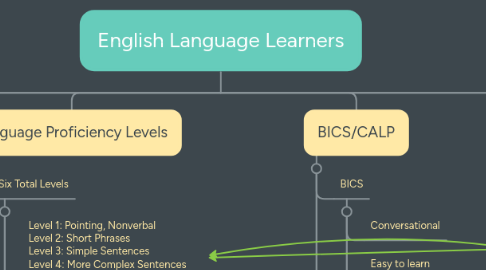
1. Teaching Language Through Content
1.1. Learn Language
1.2. The same language translates throughout the lesson
1.2.1. Example: Math incorporates language from other subjects like vocabulary about items during group work.
1.2.2. Language through sentence frames
1.2.2.1. Students learn content and new vocabulary using other phrases they already know from the sentence frames they have used in the past. They just incorporate new ideas into their work.
1.2.3. Students need to look at the vocabulary on a spectrum, making sure they are understanding the vocab in order to engage in the content.
1.3. Vocabulary important to teach throughout lessons
1.3.1. Build on vocab that you already know
1.3.1.1. Example: sight words can be used in problems in math as well as in reading, science, history, literacy, etc.
1.3.1.2. Content expressed in a way that will help the students better understand the language as a whole.
2. SADIE Strategies
2.1. Helps Scaffold EL
2.1.1. Makes sure they feel welcome/comfortable in the classroom
2.2. Multimodal
2.2.1. Manipulatives
2.2.1.1. Examples include: Counting bears, clocks, wooden blocks, flashcards, pictures
2.2.1.2. Could be used as a scaffold for different learning levels
2.2.2. Use at least 3 modes in lessons
3. Language Proficiency Levels
3.1. Six Total Levels
3.1.1. Level 1: Pointing, Nonverbal Level 2: Short Phrases Level 3: Simple Sentences Level 4: More Complex Sentences Level 5: Almost Proficient Level 6: Proficient
3.1.2. Behaviors in small group:
3.1.2.1. Students were only level three, but sometimes advanced based on the topic.
3.1.2.1.1. English: they were sometimes at the MPIs of a level 2 or three. They struggled with coming up with the right words, so they ended up speaking in phrases
3.1.2.1.2. Math: Students excelled, and one ended up speaking at a level four to explain their answers. One went back to a level two because they were unsure of the vocabulary, which ties into the content!
4. BICS/CALP
4.1. BICS
4.1.1. Conversational
4.1.2. Easy to learn
4.1.3. Students utilize this language when they are conversing with friends. Easy to write when it is like a conversation and not using academic language
4.1.3.1. Examples: "Hi, how are you," "What's up," "So I was at the store the other day...," more conversations than anything without incorporating educational concepts as much.
4.2. CALP
4.2.1. Academic
4.2.2. Hard to grasp
4.2.3. academic language
4.2.3.1. examples: anything you would put in a formal essay
4.2.3.1.1. educational concepts in mathematics: add subtract, mean, median, mode, average
4.2.3.1.2. scientific words: hypothesis, experiment, adaptation, alleles, biomes, etc.
4.3. Use when teaching lessons, incorporate vocab into lesson.
5. Leveled Questions and Key Vocabulary
5.1. Differentiate instruction
5.1.1. Reach all 6 levels
5.1.1.1. Leveled to accomplish language and content objectives
5.1.2. Level 1: Point to the word "the" Level 2: What word is this? Level 3: Tell me about what word this is? Level 4: Tell me the word "the" Level 5: Read the sentence aloud and tell me which one is the word "the" Level 6: Read the sentence and tell me the word "the." How do you know?
5.2. Vocab = what you want them to learn
5.2.1. Make sure you repeat the vocab to enrich understanding
5.2.1.1. Language Objectives
5.2.1.1.1. What sentence frames and grammar concepts or vocab you want the students to learn
5.2.1.1.2. Example: Students will understand content objective by using the sentence frame "The _________ is a part of the _______."
5.2.1.2. Content Objectives
5.2.1.2.1. Example: Students will learn to count using pennies, nickels, and dimes.
5.2.1.2.2. What you want your students to know by the end of the lesson
6. WIDA Model
6.1. Three main sections of a WIDA template
6.1.1. Language Function
6.1.1.1. Verb that the students should accomplish
6.1.2. Example topic
6.1.2.1. What the students should do in the lesson
6.1.3. Support
6.1.3.1. What modes the students should accomplish
6.1.4. Used to help students gain a better grasp of the concepts as a whole and to meet them at the EL's level in order to help them engage in the content
6.1.4.1. Content is the same, but the students are scaffolded in different ways
6.1.4.2. Helps predict what the students should be able to do, like a rubric, to help them understand what level they need to engage in the lesson.

